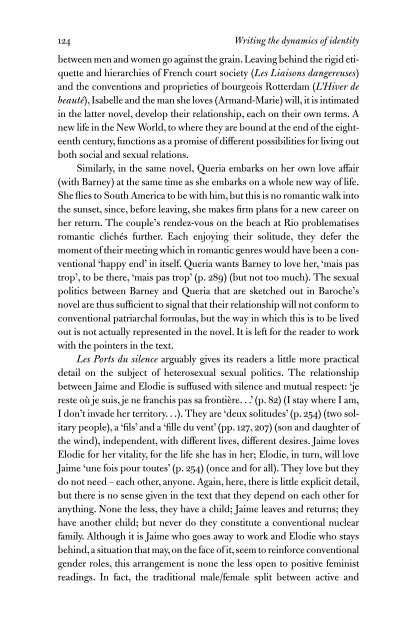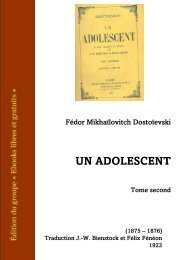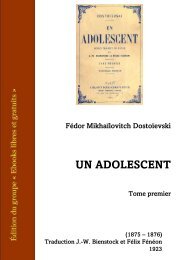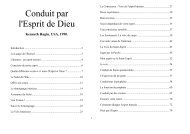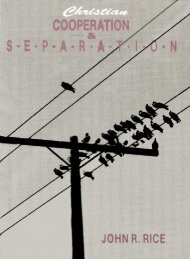Women writing in contemporary France
You also want an ePaper? Increase the reach of your titles
YUMPU automatically turns print PDFs into web optimized ePapers that Google loves.
124 Writ<strong>in</strong>g the dynamics of identity<br />
between men and women go aga<strong>in</strong>st the gra<strong>in</strong>. Leav<strong>in</strong>g beh<strong>in</strong>d the rigid etiquette<br />
and hierarchies of French court society (Les Liaisons dangereuses)<br />
and the conventions and proprieties of bourgeois Rotterdam (L’Hiver de<br />
beauté), Isabelle and the man she loves (Armand-Marie) will, it is <strong>in</strong>timated<br />
<strong>in</strong> the latter novel, develop their relationship, each on their own terms. A<br />
new life <strong>in</strong> the New World, to where they are bound at the end of the eighteenth<br />
century, functions as a promise of different possibilities for liv<strong>in</strong>g out<br />
both social and sexual relations.<br />
Similarly, <strong>in</strong> the same novel, Queria embarks on her own love affair<br />
(with Barney) at the same time as she embarks on a whole new way of life.<br />
She flies to South America to be with him, but this is no romantic walk <strong>in</strong>to<br />
the sunset, s<strong>in</strong>ce, before leav<strong>in</strong>g, she makes firm plans for a new career on<br />
her return. The couple’s rendez-vous on the beach at Rio problematises<br />
romantic clichés further. Each enjoy<strong>in</strong>g their solitude, they defer the<br />
moment of their meet<strong>in</strong>g which <strong>in</strong> romantic genres would have been a conventional<br />
‘happy end’ <strong>in</strong> itself. Queria wants Barney to love her, ‘mais pas<br />
trop’, to be there, ‘mais pas trop’ (p. 289) (but not too much). The sexual<br />
politics between Barney and Queria that are sketched out <strong>in</strong> Baroche’s<br />
novel are thus sufficient to signal that their relationship will not conform to<br />
conventional patriarchal formulas, but the way <strong>in</strong> which this is to be lived<br />
out is not actually represented <strong>in</strong> the novel. It is left for the reader to work<br />
with the po<strong>in</strong>ters <strong>in</strong> the text.<br />
Les Ports du silence arguably gives its readers a little more practical<br />
detail on the subject of heterosexual sexual politics. The relationship<br />
between Jaime and Elodie is suffused with silence and mutual respect: ‘je<br />
reste où je suis, je ne franchis pas sa frontière. . .’ (p. 82) (I stay where I am,<br />
I don’t <strong>in</strong>vade her territory. . .). They are ‘deux solitudes’ (p. 254) (two solitary<br />
people), a ‘fils’ and a ‘fille du vent’ (pp. 127, 207) (son and daughter of<br />
the w<strong>in</strong>d), <strong>in</strong>dependent, with different lives, different desires. Jaime loves<br />
Elodie for her vitality, for the life she has <strong>in</strong> her; Elodie, <strong>in</strong> turn, will love<br />
Jaime ‘une fois pour toutes’ (p. 254) (once and for all). They love but they<br />
do not need – each other, anyone. Aga<strong>in</strong>, here, there is little explicit detail,<br />
but there is no sense given <strong>in</strong> the text that they depend on each other for<br />
anyth<strong>in</strong>g. None the less, they have a child; Jaime leaves and returns; they<br />
have another child; but never do they constitute a conventional nuclear<br />
family. Although it is Jaime who goes away to work and Elodie who stays<br />
beh<strong>in</strong>d, a situation that may, on the face of it, seem to re<strong>in</strong>force conventional<br />
gender roles, this arrangement is none the less open to positive fem<strong>in</strong>ist<br />
read<strong>in</strong>gs. In fact, the traditional male/female split between active and


